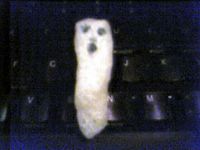Rantings of a Spoo
This is a blog reflecting the various views, interests, and quirky things that I would like to share.
Welcome to my rantings.
Thursday, December 25, 2008
Saturday, December 20, 2008
Congratulations!
Labels: college of education, ou, university of oklahoma
Friday, December 19, 2008
Searching for the Star of Bethlehem
A new theory makes the news. But are 21st-century astronomers looking in the wrong place?
Using powerful computer software, an Australian astronomer says that he has re-created the night sky over Bethlehem in the year 2 B.C. and discovered a planetary conjunction that may have been the Star of Bethlehem that drew the Magi to worship the baby Jesus.
Astronomer Dave Reneke said the close proximity of Venus and Jupiter created a spectacle in the night sky just before the summer solstice that year. Britain's Telegraph newspaper reported that Reneke went so far as to suggest that perhaps Christmas should be celebrated on June 17 rather than December 25. An interesting idea, since the December Christmas celebration probably doesn't mark the true birth day of Jesus either. The December observance has its roots in a Roman celebration of the winter solstice.
Reneke seems to assume such a celestial spectacle would automatically spur the Magi, who were Mesopotamian astrologer/astronomers, to travel a great distance to pay tribute to a newborn king. This is the weakness in most Bethlehem Star theories.
A variety of celestial spectacles have been proposed as the Star of Bethlehem. The famed 17th century astronomer Johannes Kepler suggested it was a nova, a temporarily ultra-bright star. Others have suggested a comet, although in ancient times a comet was usually perceived as a bad omen.
The story in Matthew's Gospel seems to indicate that the people of Judea were oblivious to the Star. So, at least one scholar has taken a different approach to identifying the Star of Bethlehem.
"I set out to find what a stargazer of Roman times would have recognized as the star of a new Judean king," wrote retired Rutgers University astronomer Michael Molnar in the preface of his 1999 book, The Star of Bethlehem: The Legacy of the Magi.
Owen Gingerich, professor emeritus of astronomy at Harvard University, thinks that Molnar is on the right track. "He has made a serious attempt to situate the Star in terms contemporary with the event, tying it in with numismatical evidence and Roman imperial horoscopes," he said. "Too many have tried to formulate the Star in modern terms, without considering the first century context."
Molnar said it was an ancient coin that initiated his Star quest. "That coin had Aries the Ram on it," he said in an interview. "My research of several astrological manuscripts from Roman times showed that the kingdom of Judea was represented by Aries the Ram."
Molnar's extensive research in primary sources led him to a set of conditions that "pointed like an astrological road sign to Jerusalem." On April 17, 6 B.C., the royal planet Jupiter rose as a morning star and was eclipsed (technical term: occulted) by the moon while it was located within the constellation Aries.
Later the earth in its inner orbit passed Jupiter and for a week in December of 6 B.C. Jupiter appeared to be standing still or drifting backwards. The astronomical term is retrograde motion, and could explain why Matthew 2:9 states that the Star stood still over Bethlehem.
(The birth of Jesus around 6 B.C. fits what scholars know from other sources, since the gospels indicate that Jesus was born before the death of Herod. Herod's death is believed to have occurred around 4 B.C., just after an eclipse that's mentioned in ancient sources. That Jesus was born B.C. is due to a calendar miscalculation centuries later.)
While Molnar's book laid out a what may be the strongest case so far (a review in Sky & Telescope magazine called it "the final word") for the Star of Bethlehem, astronomer Gingrich said "no reconstruction agrees with the New Testament in every detail, there is always some discrepancy."
Some Christians are satisfied with the biblical story and don't care what the astronomers think; but others would like to know if there is scientific evidence to support the Biblical account.
Edwin Yamauchi, emeritus professor of history at Miami University, and the author of Persia and the Bible, said, "It is quite legitimate to consider such scientific explanations, as long as they are not reductions which deny God's supernatural ability. God the creator can use his creation to reveal and to work his will."
Copyright © 2008 Christianity Today. Click for reprint information.
Thursday, December 18, 2008
Farewell, Majel... 1932-2008
Majel Roddenberry, widow of 'Trek' creator, dies
 LOS ANGELES - Majel Barrett Roddenberry, "Star Trek" creator Gene Roddenberry's widow who nurtured the legacy of the seminal science fiction TV series after his death, has died. She was 76. Roddenberry died of leukemia Thursday morning at her home in Bel-Air, said Sean Rossall, a family spokesman.
LOS ANGELES - Majel Barrett Roddenberry, "Star Trek" creator Gene Roddenberry's widow who nurtured the legacy of the seminal science fiction TV series after his death, has died. She was 76. Roddenberry died of leukemia Thursday morning at her home in Bel-Air, said Sean Rossall, a family spokesman.
At Roddenberry's side were family friends and her son, Eugene Roddenberry Jr.
Roddenberry was involved in the "Star Trek" universe for more than four decades. She played the dark-haired Number One in the original pilot but metamorphosed into the blond, miniskirted Nurse Christine Chapel in the original 1966-69 show. She had smaller roles in all five of its television successors and many of the "Star Trek" movie incarnations, although she had little involvement in the product![]() ions.
ions.
She frequently was the voice of the ship's computer, and about two weeks ago she completed the same role for the upcoming J.J. Abrams movie "Star Trek," Rossall said.
Roddenberry also helped keep the franchise alive by inspiring fans and attended a major "Star Trek" convention each year, Rossall said.
"I think `Star Trek' will always be her legacy," Rossall said.
"Star Trek" and its successors often focused on political and philosophical issues of the day. Roddenberry and her husband, who died in 1991, believed in creating "thoughtful entertainment" and were proud of the show and the passionate devotion of its fans, Rossall said.
"My mother truly acknowledged and appreciated the fact that `Star Trek' fans played a vital role in keeping the Roddenberry dream alive for the past 42 years. It was her love for the fans, and their love in return, that kept her going for so long after my father passed away," her son said in a statement on the official Roddenberry Web site.
Born Majel Lee Hudec on Feb. 23, 1932, in Cleveland, she began taking acting classes as a child. She had some stage roles, then in the late 1950s and 1960s had bit parts in a few movies and small roles in TV series, including "Leave It to Beaver" and "Bonanza."
She met her husba nd in 1964 during a guest role for a Marine Corps drama he produced called "The Lieutenant." That same year, she was cast in the pilot for the "Star Trek" series as the no-nonsense second-in-command. The pilot did not appeal to NBC executives and a second pilot was made, although parts of the original later showed up in a two-part episode called "The Menagerie."
nd in 1964 during a guest role for a Marine Corps drama he produced called "The Lieutenant." That same year, she was cast in the pilot for the "Star Trek" series as the no-nonsense second-in-command. The pilot did not appeal to NBC executives and a second pilot was made, although parts of the original later showed up in a two-part episode called "The Menagerie."
The couple married in Japan in 1969 after "Star Trek" was canceled. After her husband's death, Roddenberry continued her involvement with the "Star Trek" franchise.
She also was the executive producer for two other TV science fiction series, "Andromeda" and "Earth: Final Conflict."










